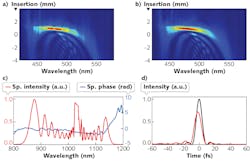Ultrafast Lasers: Few-cycle ultrafast laser system demonstrates an average power of 318 W
Ultrafast laser pulses of only a few optical cycles in length interact with matter in unique ways—a phenomenon that could, if pushed beyond the research lab, be of great benefit to industry (for example, in materials processing). Now, a team of researchers from Active Fiber Systems GmbH (AFS; Jena, Germany), the Max Born Institute for Nonlinear Optics and Short Pulse Spectroscopy (MBI; Berlin, Germany), and Laser-Laboratorium Göttingen e.V. (LLG; Göttingen, Germany) has begun such a push by creating an ultrafast laser system that generates multimillijoule three-cycle pulses at a 318 W average power level.1 These results mark a significant milestone in few-cycle laser technology, paving the way towards industrial applications. Furthermore, it is an important step towards the realization of the so-called HR2 laser system, which is being developed by AFS for the attosecond light facility of the Extreme Light Infrastructure (ELI-ALPS; Szeged, Hungary).
Extremely short light pulses containing only a few electromagnetic-field oscillations are among the fastest events ever made by humankind. Although the first few-cycle pulses were produced about 30 years ago, they could only be used in cutting-edge science—for example, for time-resolved studies or attosecond pulse generation. To find their way into industrial use, a number of major challenges need to be addressed, such as turnkey operation and energy and power upscaling of the few-cycle sources.
Stretched flexible hollow fiber meets coherently combined multichannel fiber amplifiers
The scientists followed a novel approach by directly compressing 300-fs-long pulses from a new, record-breaking high-energy, high-power laser system to the few-cycle duration (see figure). This requires a 30X compression, which has only recently become feasible by the introduction of stretched flexible gas-filled hollow-fiber technology, and which offers almost unrestricted-length scalability.
In the study, a coherently combined multichannel ytterbium (Yb)-doped fiber laser—which is the largest of its kind—delivering up to 10 mJ pulses at up to 1 kW average power and a 1.03 μm center wavelength was used as the light source developed by AFS. For the pulse compression, a 6-m-long stretched flexible hollow fiber was used, which was developed together by LLG and MBI.
As the pulses propagate through the argon gas filling the hollow waveguide, self-phase modulation takes place between the intense light and the gas atoms, which broadens the spectrum. The pulses with substantially broadened spectrum can then be compressed to a shorter duration by compensating their spectral phase with a set of chirped mirrors. In this way, the team succeeded in generating multimillijoule 10 fs pulses at a 100 kHz repetition rate and an average power of 318 W, which is the highest average power ever achieved for a few-cycle laser.
This shows that, by using stretched flexible hollow-core fiber technology, high-power industry-grade lasers can be brought into the few-cycle regime, opening up new possibilities for industrial applications such as highly parallelized materials processing. In addition to providing the HR2 laser system to the major European user facility ELI-ALPS, this development holds promise of completing the transformation of few-cycle technology from research device to industrial tool.
REFERENCE
1. T. Nagy et al., Optica, 6, 1423–1424 (2019); https://doi.org/10.1364/optica.6.001423.

John Wallace | Senior Technical Editor (1998-2022)
John Wallace was with Laser Focus World for nearly 25 years, retiring in late June 2022. He obtained a bachelor's degree in mechanical engineering and physics at Rutgers University and a master's in optical engineering at the University of Rochester. Before becoming an editor, John worked as an engineer at RCA, Exxon, Eastman Kodak, and GCA Corporation.
